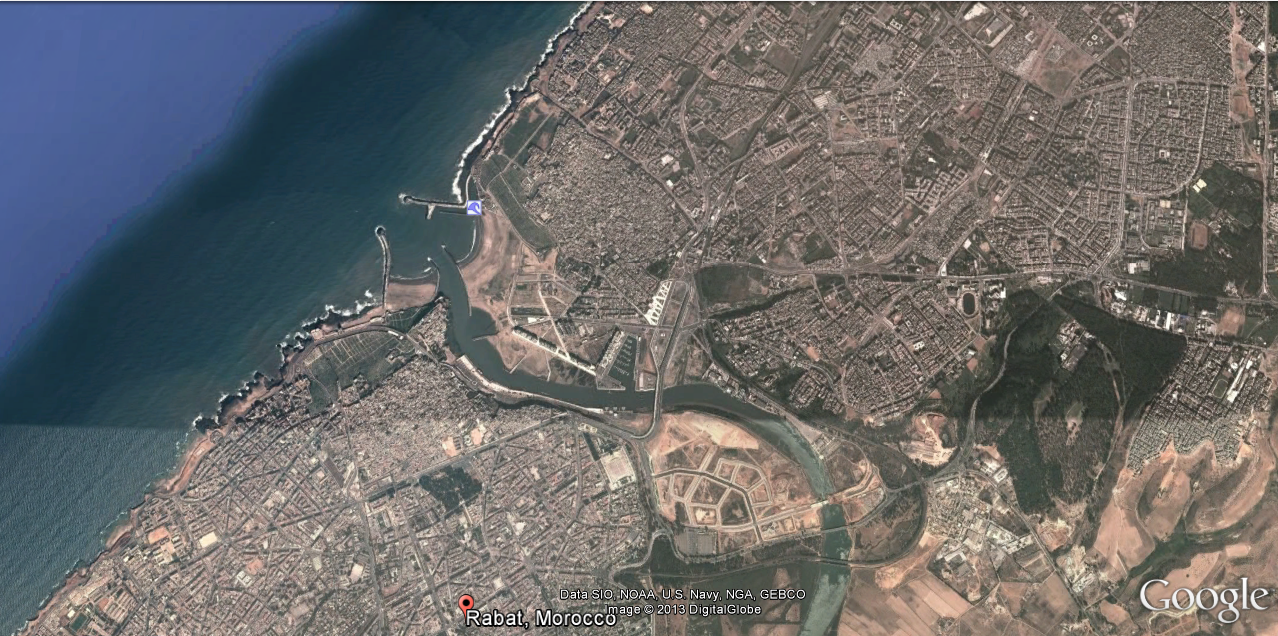 Source: Google Earth
Source: Google EarthRabat is the second largest city and capital of Morocco, and the administrative center of the Rabat-Sale-Zemmour-Zaër Region. The city is divided into five districts, with a population of 623,457 inhabitants according to the 2004 census. As the headquarters of the financial sector of Morocco, Rabat contributes 12.6% of the national GDP. Rabat is governed by a city council composed of the mayor, or council president, Fathallah Oualalou and 12 vice presidents.
Projected average annual temperature increases of up to 5.6°C by the 2090s, projected 15-29% decreases in annual rainfall by 2090, and sea level rise that will affect 35,000 people and the equivalent of 4.9 Billion US dollars in exposed assets by 2070 are the primary climate hazards facing Rabat. The city’s key population vulnerabilities include the 34% of households classified as slums and 2.4% of households living below a poverty line equivalent to $472.72 per person per year. Geographic vulnerabilities include the 50% deficit in the local watershed, and the major capital investment in developing the “formerly swampy” Bouregreg River Valley. Adaptive capacity is currently low in Rabat where the Municipal Development Plan does not address the issue of climate change, and urban planning has historically ignored vulnerability to flooding.
This climate risk assessment (Mehrotra et al., 2009) shows that two main risks facing Rabat are water scarcity and damage to the development along the river. The majority of the city’s slums currently lack access to water and all projections point to decreasing resources in the future. The Bouregreg River Valley development will be increasingly subject to damage from storm surge events in the future. Based on the small size of the city, and the identified climate change risks we propose that Rabat prioritize an adaptive climate change response strategy focused on water infrastructure.
The city should incorporate proactive water use management into the Municipal Development Plan. Central elements would include emphasizing conservation and maintenance of existing water resources, planning for future droughts, and extending municipal water infrastructure and services into informal districts and slums.
Building codes should be changed to account for climate change risks related to flooding and storm surge. New zoning should incentivize building away flood-prone areas, require documentation of flood risk and insurance for existing structures, and make flood-proofing retrofits a requirement for the permitting of any improvements to existing structures.
The City Council should establish a permanent committee on climate change response. Responsibilities of the committee will include promoting awareness of climate variability, change, and potential impacts on Rabat, overseeing implementation of the new water use management plan, and develop and enforcing a timeline for required flood-proofing of all structures in the Bouregreg River Valley.
Funding should be allocated to extend municipal water infrastructure and services into informal districts and slums. Funds allotted for further development in the Bouregreg River Valley will be redirected to cover the costs of increasing water infrastructure. Water service costs will be subsidized for households below the poverty line through a tax on businesses and industries that fail to comply with new conservation standards.
References
Atillah, A. E. H., D. (2011). Tsunami vulnerability and damage assessment in the coastal area of rabat and sale, morocco. Natural Hazards and Earth System Sciences, 11(12), 3397-3414.
Bigio, A. G., Hallegatte, S., Rouhana, S., Tiwari, A., Hamad, O., & Carrington, T. (2011). North african coastal cities address natural disasters and climate changeThe World Bank.
Brown, S., Kebede, A. S., & Nicholls, R. J. (2011). Sea-level rise and impacts in africa, 2000 to 2100, from
City governance. (2013). Retrieved November 21, 2013from http://rabat2013.com/rabat/gouvernance
City profile. Retrieved September 26, 2013, from http://rabat2013.com/rabat/profilrabat
Findlay, A. M., Paddison, R. (1986) Planning the Arab city: The cases of Tunis and Rabat, Progress in Planning, Volume 26, Part 1, Pages 1-82,, http://dx.doi.org/10.1016/0305-9006(86)90006-1.(http://www.sciencedirect.com/science/article/pii/0305900686900061
G. Bigio, A. (2009). Adapting to climate change and preparing for natural disasters in the coastal cities of North Africa The World Bank.
German Federal Ministry for Economic Cooperation and Development (BMZ). Climate change adaptation. Retrieved September 25, 2013, from http://www.giz.de/themen/en/37930.htmIt’s 4 you tours.http://www.geog.ox.ac.uk/research/climate/projects/undp-cp/UNDP_reports/Morocco/Morocco.hires.report.pdf
McSweeny, C., New, M., & Lizcano, G. (2012). UN climate change country profiles: Morocco.
Mehrotra, S., C.E. Natenzon, A. Omojola, R. Folorunsho, J. Gilbride & C. Rosenzweig. (2009). Framework for city climate risk assessment. Washington, DC: World Bank.